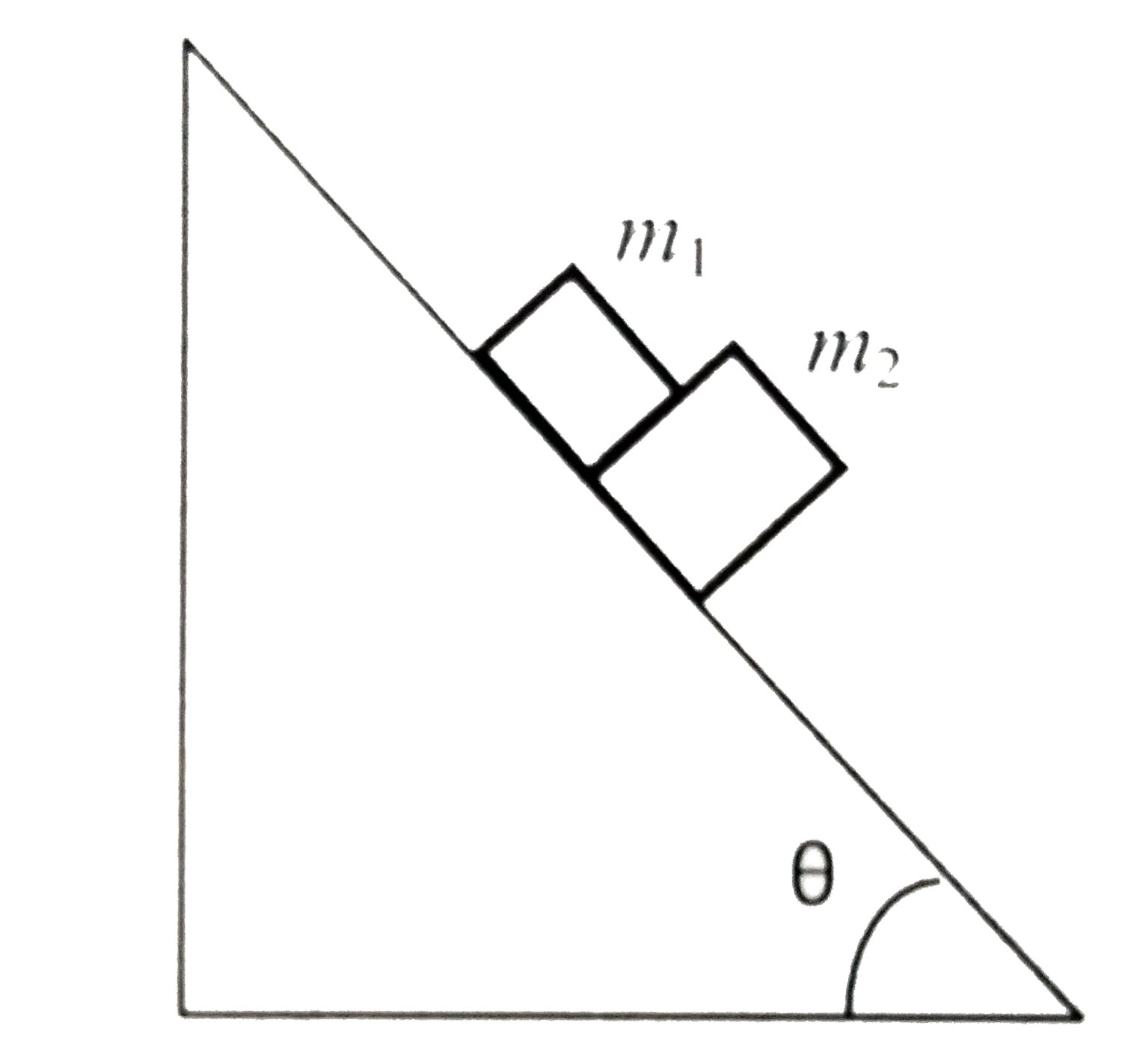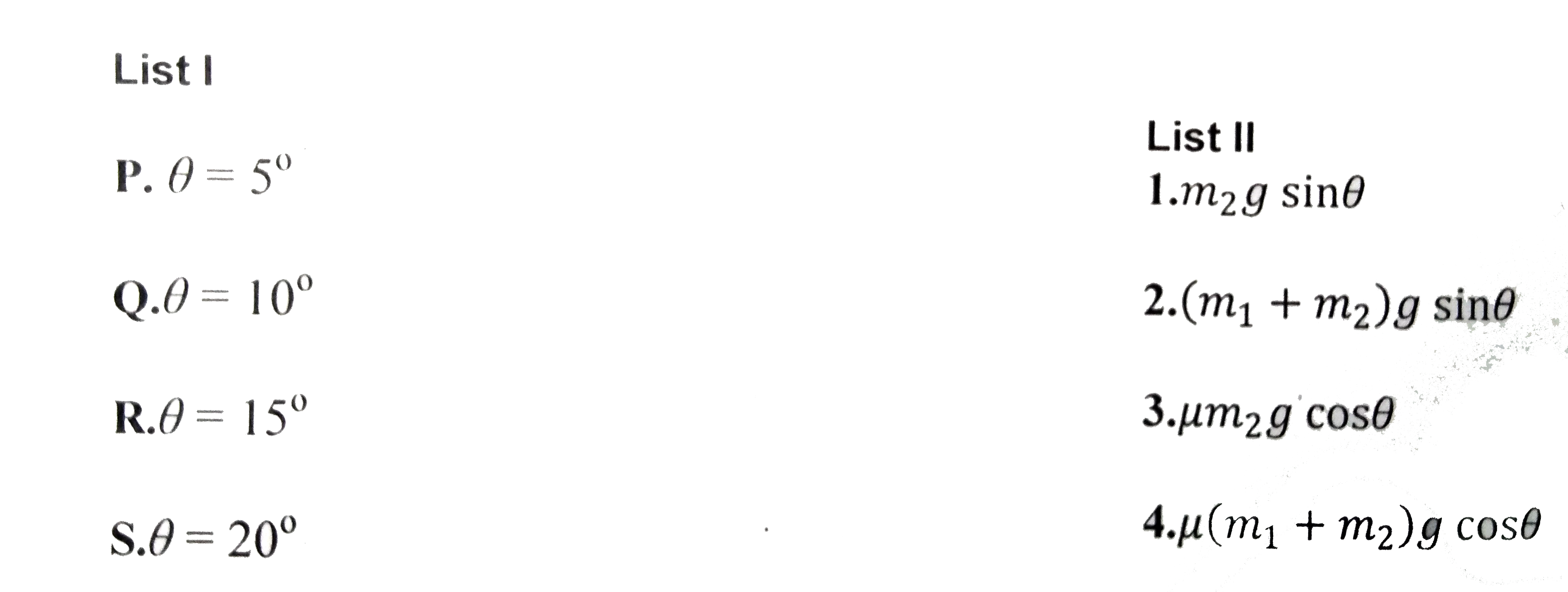A block of mass m1=1kg and another mass m2=2kg are placed together(see figure) on an inclined plane with angle of inclination θ varius value of θ are given in list 1 The coefficient of friction between the block m1 and the plank is always zero The coefficient of static and dynamic friction between the block m2 and the plank are equal to μ=0.3 In List II experssions for the friction the block m2 are given Match the correct experssions of the frictionless in List II with the angle given in list 1 and choice the correct option The acceleration due too gravity detented by g
[Useful information tan(5.5∘)=0.1tan(11.5∘)=0.2tan(16.5∘)=0.3]
List I
P. θ=5∘ Q. θ=10∘
R. θ=15∘ S. θ=20∘
List 2
1.m2gsinθ 2.(m1+m2)gsinθ
3.μm2gcosθ 4. μ(m1+m2)gcosθ
a. P−1,Q−1,R−1,S−3
b. P−2,Q−2,R−2,S−3
c.P−2,Q−2,R−2,S−4
d. P−2,Q−2,R−3,S−3
The correct Answer is:d
To solve the problem step by step, we will analyze the forces acting on the blocks on the inclined plane and determine the correct expressions for the frictional force based on the given angles.
Step 1: Understand the Forces Acting on the Blocks
- We have two blocks: m1=1kg (block on top) and m2=2kg (block on the bottom).
- The angle of inclination is θ.
- The coefficient of friction between m2 and the plank is μ=0.3.
- The friction between m1 and the plank is zero.
Step 2: Identify the Forces on Block m2
- The gravitational force acting on m2 is m2g.
- The component of the gravitational force acting down the incline is m2gsinθ.
- The normal force acting on m2 is N=m2gcosθ.
Step 3: Determine the Condition for No Slipping
For block m2 to not slip, the frictional force must balance the component of the gravitational force acting down the incline. The frictional force f can be expressed as:
f≤μN=μm2gcosθ
Setting the forces equal for the case of static friction:
f=m2gsinθ
Step 4: Set Up the Inequality
For no slipping:
m2gsinθ≤μm2gcosθ
Dividing through by m2g (assuming g≠0):
sinθ≤μcosθ
Step 5: Convert to Tangent Form
Using the identity tanθ=sinθcosθ:
tanθ≤μ
Step 6: Substitute the Values
Substituting μ=0.3:
tanθ≤0.3
Step 7: Calculate the Corresponding Angles
Using the given values:
- tan(5.5∘)=0.1
- tan(11.5∘)=0.2
- tan(16.5∘)=0.3
From this, we can conclude:
- For θ=5∘ and θ=10∘, tanθ<0.3, so the frictional force is given by m2gsinθ.
- For θ=15∘ and θ=20∘, tanθ≥0.3, so the frictional force is given by μm2gcosθ.
Step 8: Match the Expressions
Now we match the expressions from List II:
- For P:θ=5∘ and Q:θ=10∘, the expression is m2gsinθ (Expression 1).
- For R:θ=15∘ and S:θ=20∘, the expression is μm2gcosθ (Expression 3).
Final Matching:
- P (5°) → Expression 1: m2gsinθ
- Q (10°) → Expression 1: m2gsinθ
- R (15°) → Expression 3: μm2gcosθ
- S (20°) → Expression 3: μm2gcosθ
Summary of the Solution:
- P matches with Expression 1
- Q matches with Expression 1
- R matches with Expression 3
- S matches with Expression 3
- We have two blocks: m1=1kg (block on top) and m2=2kg (block on the bottom).
- The angle of inclination is θ.
- The coefficient of friction between m2 and the plank is μ=0.3.
- The friction between m1 and the plank is zero.
- The gravitational force acting on m2 is m2g.
- The component of the gravitational force acting down the incline is m2gsinθ.
- The normal force acting on m2 is N=m2gcosθ.
For block m2 to not slip, the frictional force must balance the component of the gravitational force acting down the incline. The frictional force f can be expressed as:
f≤μN=μm2gcosθ
f=m2gsinθ
For no slipping:
m2gsinθ≤μm2gcosθ
sinθ≤μcosθ
Using the identity tanθ=sinθcosθ:
tanθ≤μ
Substituting μ=0.3:
tanθ≤0.3
Using the given values:
- tan(5.5∘)=0.1
- tan(11.5∘)=0.2
- tan(16.5∘)=0.3
- For θ=5∘ and θ=10∘, tanθ<0.3, so the frictional force is given by m2gsinθ.
- For θ=15∘ and θ=20∘, tanθ≥0.3, so the frictional force is given by μm2gcosθ.
Now we match the expressions from List II:
- For P:θ=5∘ and Q:θ=10∘, the expression is m2gsinθ (Expression 1).
- For R:θ=15∘ and S:θ=20∘, the expression is μm2gcosθ (Expression 3).
- P (5°) → Expression 1: m2gsinθ
- Q (10°) → Expression 1: m2gsinθ
- R (15°) → Expression 3: μm2gcosθ
- S (20°) → Expression 3: μm2gcosθ
- P matches with Expression 1
- Q matches with Expression 1
- R matches with Expression 3
- S matches with Expression 3
Topper's Solved these Questions
- BOOK - CENGAGE PHYSICS ENGLISHCHAPTER - NEWTON'S LAWS OF MOTION 2EXERCISE - Multiple correct answer type3videos
NEWTON'S LAWS OF MOTION 2
- BOOK - CENGAGE PHYSICS ENGLISHCHAPTER - NEWTON'S LAWS OF MOTION 2EXERCISE - Assertion -reasoning2videos
NEWTON'S LAWS OF MOTION 2
- BOOK - CENGAGE PHYSICS ENGLISHCHAPTER - NEWTON'S LAWS OF MOTION 2EXERCISE - True And False4videos
NEWTON'S LAWS OF MOTION 2
- BOOK - CENGAGE PHYSICS ENGLISHCHAPTER - NEWTON'S LAWS OF MOTION 1EXERCISE - Integer5videos
NEWTON'S LAWS OF MOTION 1
- BOOK - CENGAGE PHYSICS ENGLISHCHAPTER - PROPERTIES OF SOLIDS AND FLUIDSEXERCISE - INTEGER_TYPE2videos
PROPERTIES OF SOLIDS AND FLUIDS
Similar Questions
A block of mass m1 = 1 kg another mass m2 = 2 kg, are placed together (see figure) on an inclined plane with angle of inclination θ. Various values of θ are given in List I. The coefficient of friction between the block m1 and the plane is always zero. The coefficient of static and dynamic friction between the block m2 and the plane are equal to μ=0.3 . In List II expressions for the friction on block m2 are given. Match the correct expression of the friction in List II with the angles given in List I, and choose the correct option. The acceleration due to gravity is denoted by g
[Useful information :tan(5.5∘)≈0.1,tan(11.5∘)≈0.2,tan(16.5∘)≈0.3].

 View Solution
View SolutionA block of mass m slides down an inclined plane of inclination θ with uniform speed. The coefficient of friction between the block and the plane is μ. The contact force between the block and the plane is
View Solution
Knowledge Check
- Question 1 - Select One
A block of mass 2kg rests on a rough inclined plane making an angle of 30∘ with the horizontal. The coefficient of static friction between the block and the plane is 0.7. The frictional force on the block is
A10.3NB23.8NC11.9ND6.3N - Question 2 - Select One
A block of mass 3 kg rests on a rough inclined plane making an angle of 30∘. With the horizontal. The coefficient of static friction between the block and the plane is 0.7. The frictional force on the block is
A9.8 NB0.7×9.8×√3 NC9.8×√3 ND0.7×9.8 N
A block of mass 2kg rests on a rough inclined plane making an angle of 30∘ with the horizontal. The coefficient of static friction between the block and the plane is 0.7. The frictional force on the block is
View SolutionA block of mass m slides down an inclined plane which makes an angle θ with the horizontal. The coefficient of friction between the block and the plane is μ. The force exerted by the block on the plane is
View SolutionA block of mass m is placed at rest on an inclination θ to the horizontal. If the coefficient of friction between the block and the plane is μ, then the total force the inclined plane exerts on the block is
View SolutionA block of mass m is kept on an inclined plane is angle inclination θ(<ϕ), where ϕ= angle of friction. Then :
 View Solution
View SolutionA block of mass m=4kg is placed over a rough inclined plane as shown in fig . The coefficient of friction between the block and the plane μ=0.5 A force F=10N is applied on the block at an angle of 30∘. Find the contact force between the block and the plane.
k
 View Solution
View SolutionA block of mass 5 kg is placed on a rough inclined plane. The inclination of the plane is gradually increased till the block just begins to slide down. The inclination of the plane is than 3 in 5. The coefficient of friction between the block and the plane is (Take, g=10m/s2)
View Solution

